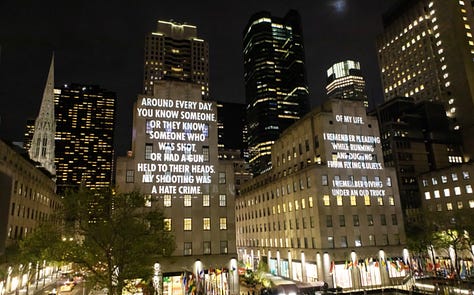In the spring of 1992, Vedran Smajlovic donned a black jacket and tie and sat down with his cello at a bomb crater in Sarajevo, where the day before, 22 people had been killed by a mortar shell while waiting in line for bread. He played Albinoni’s “Adagio in G Minor.”
In 2015, the conductor of the Iraqi National Symphony, Karim Wasfi, brought his cello to the central Baghdad district of Karrada to play at the site of a blast. And in March 2022, Denys Karachevtsev did the same in Kharkiv, Ukraine. After each bomb, they packed up their cellos and went toward the devastation.
This month marks a year since children and teachers were killed inside their elementary school in Uvalde, Texas and I have been thinking about how each mass shooting in the United States leaves a physical and psychic crater in the earth where the violence has happened, whether it’s at a grocery store, a grade school, a dance studio or a shopping mall. It’s a kind of blast zone that destroys the humans there, leaving behind the injured, the families facing profound loss, the witnesses. And to some extent, we’re all witnesses in this, whether it comes to us via a phone call or a news headline. Each of us, every day are absorbing this. So what can we do for ourselves and one another on the daily?

What is the role of art in the face of a horror so indiscriminate and indecipherable? Artist Jenny Holzer has used her text-based art to put messages about gun violence on the sides of trucks and light projections onto buildings like the Rockefeller Center. The artist Pedro Reyes melted guns down and created musical instruments. And the Cuban-born sculptor and installation artist, Felix Gonzalez-Torres worked with billboards, candy, and something called paper stacks.
Gonzalez-Torres worked in New York City in the 80s and early 90s. His work often dealt with personal and global concerns such as AIDS, U.S. foreign policy, gun control, racism, and homophobia. His piece “Untitled” (Death by Gun) is a stack of papers on the floor so precise that it looks like a kind of cube — on each sheet: the names of the 460 individuals killed by guns in the United States during the week of May 1-7, 1989. It cited name, age, city and state with a brief description of the circumstances of their deaths and photos of the deceased. Visitors to the gallery were allowed to pull a page from the stack and take it home and at the end of each day, pages were replenished to the stack so it remained the same height. The pages functioned as a kind of memorial, a marker of a loss, and a documentation of each person’s story.
Most days I walk my 16-year-old daughter to the corner where she catches the public bus and rides to her high school. We walk by a telephone pole with a nest of Flickers inside, and under a fir tree where a Downy Woodpecker has marked the bark with tiny precise holes. People pass by walking their dogs, or ease their cars out of driveways on the way to work. The elementary school across the street rings a bell at 8, so we know when we’re running behind. We talk about nothing in particular and she socks my shoulder and says “Slug Bug!” when we pass a rundown white Volkswagen. Each day I vow to get her the next day, but she always remembers first. I hug her when we part at the stop and on my walk back home, my head fills with a chant/prayer of protection: Keep her safe. Keep her safe. I recognize my immense good fortune and I know too that “life is a spell so exquisite that everything conspires to break it.” (thank you, Emily Dickinson)
In Sarajevo, Smajlovic returned to the blast site every day for 22 days, until he’d played once for every life lost. He brought his art and offered it with constancy. How do we show up with art and beauty, in a sustained way?
One Truth, One Dare
This leads us to this month’s Truth & Dare: the Cello Effect
What’s the equivalent of our going to the blast zone with a cello? To me it means not looking away from the gun violence, (not that we must read to the bottom of every news article, which would be daily and unending), but we absorb what we can, we agitate for smarter gun legislation, and we make art when possible.
Truth: Catharsis Writing: Set a timer for 30 minutes and write about gun violence – think of it as tipping your head upside down and dumping out the contents. Write about stories you remember, write about the first time you became aware of a mass shooting, write about the particular stories of people you know who have been lost, or people you have read about. Write a list of fears around gun violence. Just make some text and then set that burden down.
Dare: Find a piece of paper (whatever size speaks to you) and create a piece of text in the style of Jenny Holzer or a page in the style of Gonzalez-Torres that features a person or people affected by gun violence. You can pull words or phrasing from your “Truth” if you like. Collage, colored-pencils, paint – anything goes.
Double Dog Dare: Make a copy of your page and staple it to a telephone pole in your neighborhood.
Good luck, friends. Thank you for reading this far and hope wherever you are in this perilous universe, you’re safe and well, writing and making art..